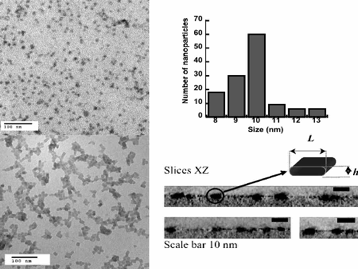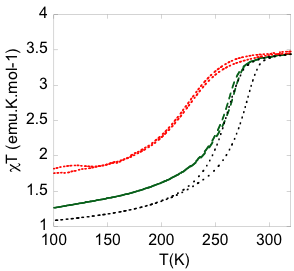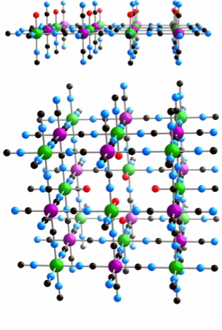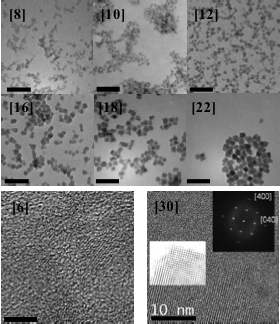Chimie Inorganique
Magnetic nanosystems
Axis 2 - Coordination nanoparticles for data storage
Matrix-dependent cooperativity in spin crossover Fe(pyrazine)Pt(CN)4 nanoparticles
Anisotropic nanoparticles of the Fe(pyrazine)Pt(CN)4 network were embedded in various matrices that revealed a dramatic effect on the cooperative spin crossover phenomena. By a judicious choice of the nature and thickness of the matrix, a thermal hysteresis of 15 K width was achieved close to room temperature for such nanoobjects.


(left) TEM image and distribution of 10 nm NPs dispersed in chloroform and slices redrawn from the reconstructed volume in the XZ direction
(right) Spin crossover for the particles embedded in different matrices (red: thick 5 nm silica shell, green: calixarene shell, black thin 2 nm silica shell)
Matrix-dependent cooperativity in spin crossover Fe(pyrazine)Pt(CN)4 nanoparticles. Y. Raza, F. Volatron, S. Moldovan, O. Ersen, V. Huc, C. Martini, F. Brisset, A. Gloter, O. Stephan, A. Bousseksou, L. Catala, T. Mallah (2011) Chem. Commun. 47 (41), 11501-11503
Controlled growth of Prussian blue analogue (PBA) nanoparticles
CsNiCr(CN)6 coordination nanoparticles with sizes ranging from 6 to 30 nm were obtained by the seed growth process. Their static and dynamic magnetic behaviours allow unravelling surface anisotropy and interparticle dipolar interaction effects. The single magnetic domain critical size was thus evaluated to be around 22 nm with a blocking temperature of 21 K (at ν = 1 Hz) and an effective energy barrier for the reversal of the magnetization of 426 K.


(left) Schematic view of the face centered cubic structure of the CsNiCr PBA nanoparticles highlighting the surface composition
(right) TEM images for particles ranging from 6 to 30 nm
Magnetization Reversal in CsNiIICrIII(CN)6 Coordination Nanoparticles: Unravelling Surface Anisotropy and Dipolar Interaction Effects. Y. Prado, S. Mazerat, E. Rivière, G. Rogez, A. Gloter, O. Stéphan, L. Catala, T. Mallah (2014) Adv. Funct. Mater. 24 (34), 5402-5411
Last update on 06.21.2019

